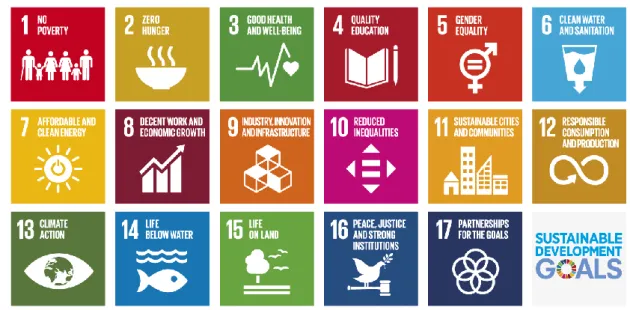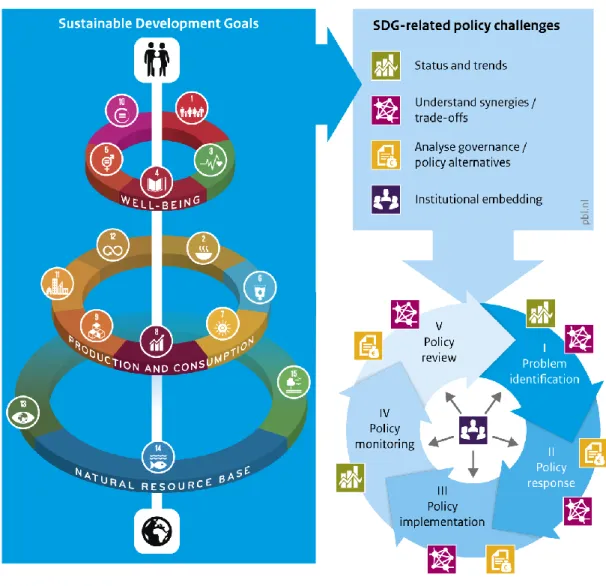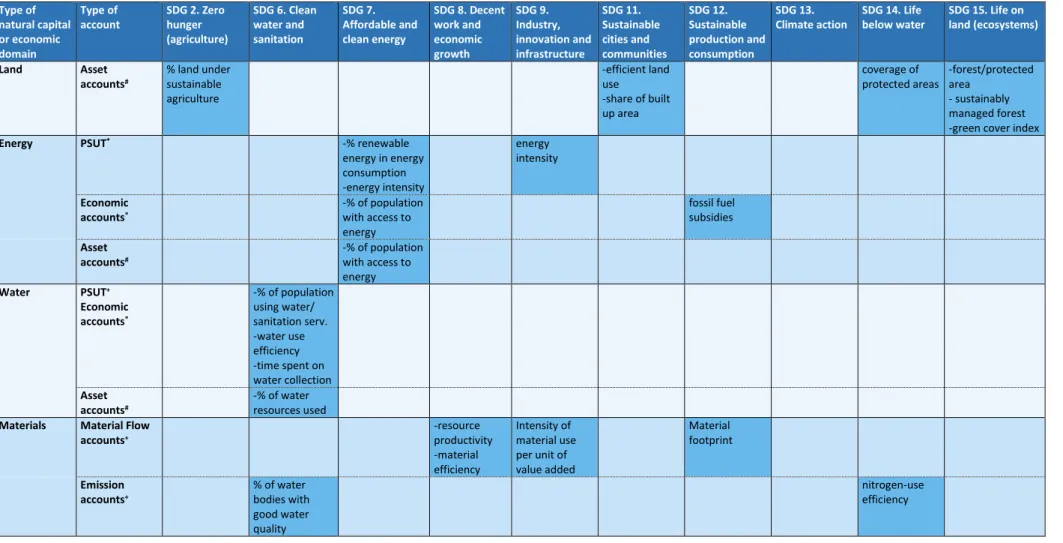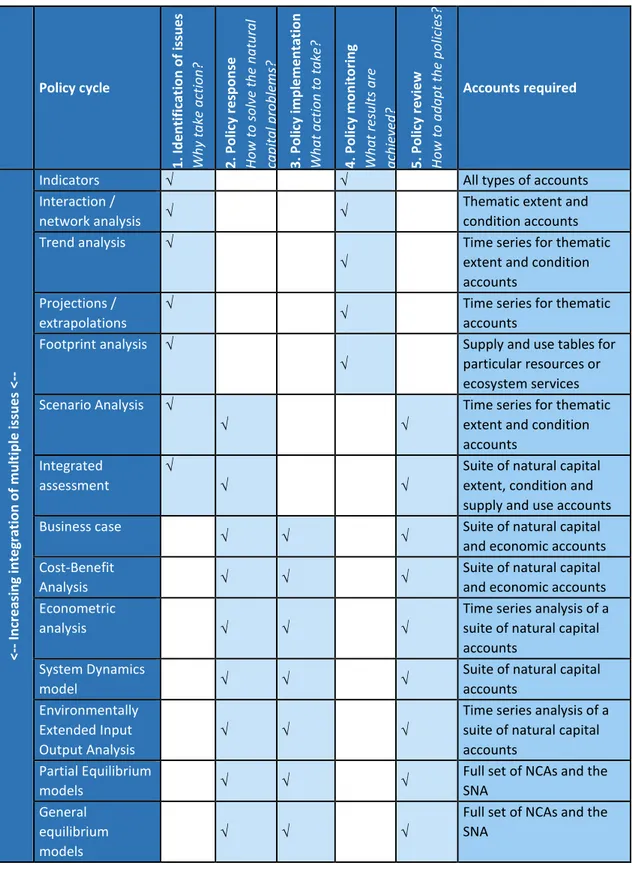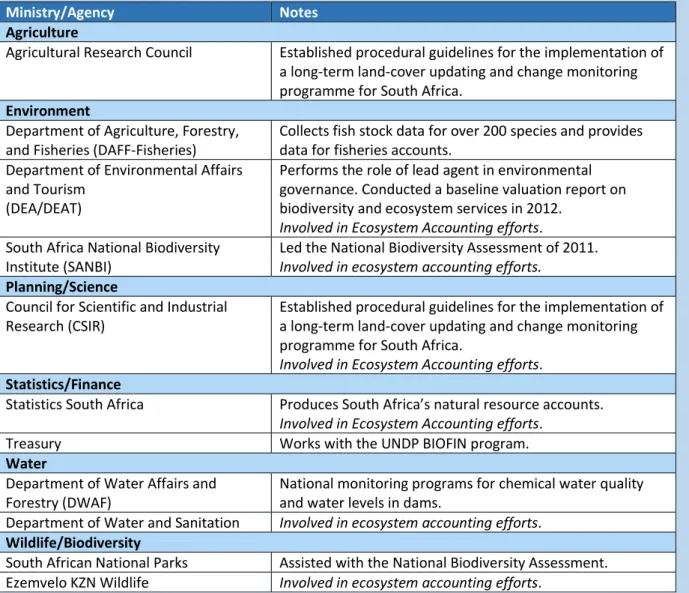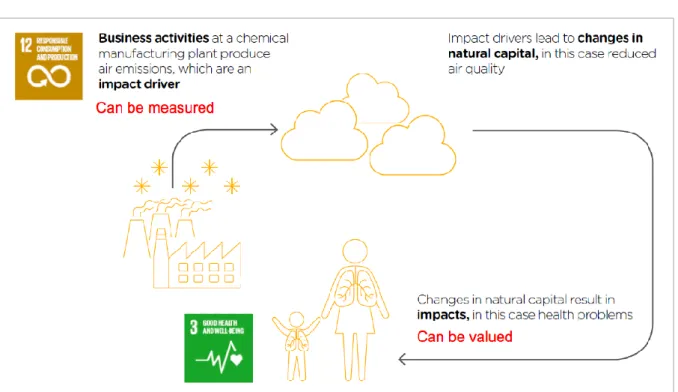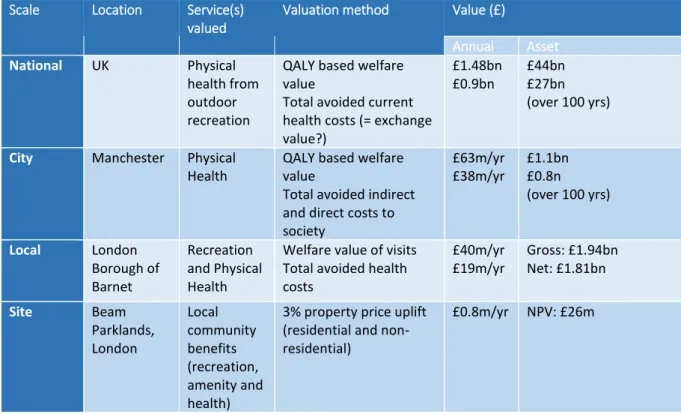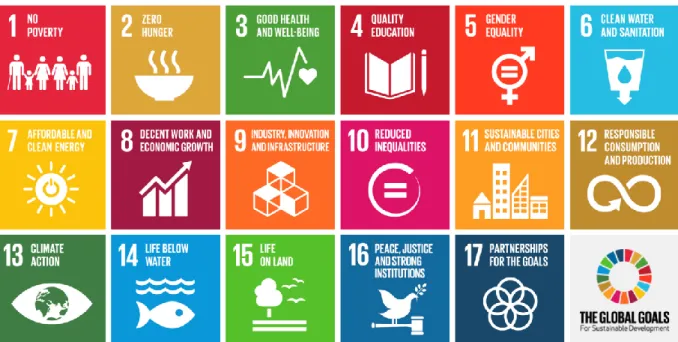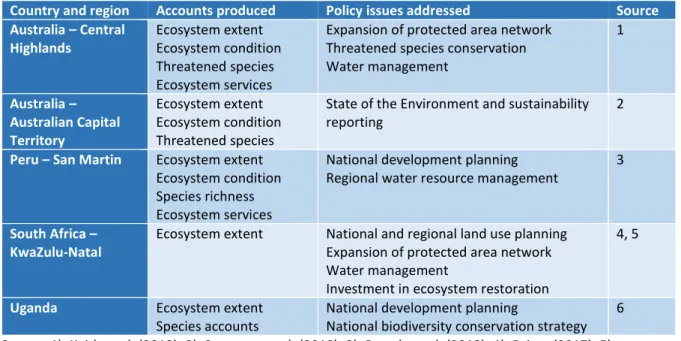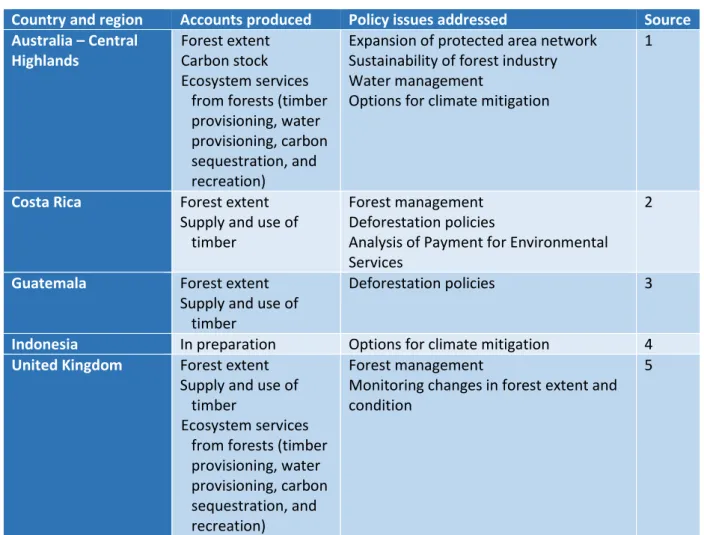2
ndPOLICY FORUM ON
Natural Capital Accounting
for Better Decision Making
Applications for Sustainable Development
Edited by Arjan Ruijs and Michael Vardon
WAVES is a World Bank-led global partnership that aims to promote sustainable development by ensuring that natural resources are mainstreamed in development planning and national economic accounts.
© 2018 International Bank for Reconstruction and Development / The World Bank 1818 H Street NW
Washington, DC 20433 Telephone: 202-473-1000 Internet: www.worldbank.org
This work is a product of the staff of The World Bank with external contributions. The findings, interpretations, and conclusions expressed in this work do not necessarily reflect the views of The World Bank, its Board of Executive Directors, or the governments they represent. The World Bank does not guarantee the accuracy of the data included in this work. The boundaries, colors, denominations, and other information shown on any map in this work do not imply any judgment on the part of The World Bank concerning the legal status of any territory or the endorsement or acceptance of such boundaries.
Rights and Permissions
The material in this work is subject to copyright. Because The World Bank encourages dissemination of its knowledge, this work may be reproduced, in whole or in part, for noncommercial purposes as long as full attribution to this work is given.
Any queries on rights and licenses, including subsidiary rights, should be addressed to World Bank Publications, The World Bank Group, 1818 H Street NW, Washington, DC 20433, USA; fax: 202-522- 2625; e-mail: pubrights@worldbank.org.
Suggested Citation
Ruijs, A. and Vardon, M. (Eds) (2018). 2nd Policy Forum on Natural Capital Accounting for Better
Decision Making: Applications for Sustainable Development. World Bank WAVES, Washington D.C.
Contents
ACKNOWLEDGEMENTS ... 7
PREFACE ... 9
PART 1 - TAKEAWAYS FROM THE 2ND POLICY FORUM ON NATURAL CAPITAL ACCOUNTING FOR BETTER DECISION MAKING ... 11
1. REPORT OF THE 2ND POLICY FORUM ON NATURAL CAPITAL ACCOUNTING FOR BETTER DECISION MAKING (THE HAGUE, 22-23 NOVEMBER 2017) ... 13
BY STEVE BASS1 1.1 INTRODUCTION ... 13
1.2 SESSION 1:WELCOME AND OPENING ... 14
1.3 SESSION 2:NCA AND THE SDGS –OVERVIEW ... 15
1.4 SESSION 3:THE ROLE OF BUSINESS ... 15
1.5 SESSION 4:POVERTY AND GREEN GROWTH ... 16
1.6 SESSION 5:LIFE ON LAND ... 17
1.7 SESSION 6:NCA FOR GOVERNMENT PROCESSES ... 18
1.8 SESSION 7:NCA FOR ASSESSING TRADE-OFFS ... 19
1.9 SESSION 8:WAYS FORWARD ... 20
1.10 SESSION 9:SUMMARY AND NEXT STEPS ... 23
ANNEX 1.1 AGENDA FOR THE 2ND POLICY FORUM ... 24
ANNEX 1.2 FORUM PARTICIPANT LIST... 27
2. NATURAL CAPITAL ACCOUNTING FOR THE SUSTAINABLE DEVELOPMENT GOALS: CURRENT AND POTENTIAL USES AND STEPS FORWARD ... 31
BY ARJAN RUIJS,1 MARTIJN VAN DER HEIDE2 AND JOLANDA VAN DEN BERG2 2.1 INTRODUCTION ... 31
2.2 CHALLENGES TO ACHIEVE THE SUSTAINABLE DEVELOPMENT GOALS ... 35
2.3 NATURAL CAPITAL ACCOUNTS FOR DEVELOPING SDG INDICATORS ... 36
2.4 NATURAL CAPITAL ACCOUNTS FOR ANALYZING INTEGRATED SDG POLICIES ... 54
2.5 INSTITUTIONAL PROCESS ... 59
2.6 CONCLUSIONS AND STEPS FORWARD ... 62
2.7 REFERENCES ... 63
APPENDIX 2.1 THE SUSTAINABLE DEVELOPMENT GOALS ... 66
3. THE ROLE OF BUSINESS IN NATURAL CAPITAL ACCOUNTING AND THE SUSTAINABLE DEVELOPMENT GOALS ... 69
BY CHRIS BROWN,1 IAN DICKIE,2 JOSEPH HARRIS-CONFINO,3 PETRI LEHTONEN,4 CARL OBST5 AND HANNAH PITTS3 3.1 INTRODUCTION TO NATURAL CAPITAL ASSESSMENTS IN BUSINESS ... 69
3.2 CASE STUDY:INDONESIA... 73
3.3 CASE STUDY:RWANDA ... 75
3.4 CASE STUDY:URBAN NATURAL CAPITAL ACCOUNTS IN THE UNITED KINGDOM... 76
3.5 HOW CAN PUBLIC AND PRIVATE APPROACHES OF NATURAL CAPITAL ACCOUNTING COMBINE FORCES TO ADVANCE OUR SHARED OBJECTIVE OF BETTER NATURAL CAPITAL MANAGEMENT? ... 78
3.6 CLOSING WORDS ... 80
4. NATURAL CAPITAL ACCOUNTING: GROWING EXPERIENCE AND TESTING THE 10 LIVING PRINCIPLES
TO MAKE IT FIT FOR POLICY... 83
BY ARJAN RUIJS1 AND MICHAEL VARDON2 4.1 INTRODUCTION ... 83
4.2 APPLYING NATURAL CAPITAL ACCOUNTING TO ATTAIN THE SDGS ... 84
4.3 APPLYING NATURAL CAPITAL ACCOUNTING TO BIODIVERSITY, CARBON AND FORESTS ... 87
4.4 ASSESSMENT OF EXPERIENCE AGAINST THE 10 LIVING PRINCIPLES ... 90
4.5 CONCLUSIONS ... 95
4.6 ACKNOWLEDGEMENTS ... 96
4.7 REFERENCES ... 96
PART 2 – CASE STUDIES ... 101
ECOSYSTEM ACCOUNTING TO INFORM DECISIONS ABOUT FOREST MANAGEMENT IN THE CENTRAL HIGHLANDS, AUSTRALIA ... 105
BY HEATHER KEITH, MICHAEL VARDON AND DAVID LINDENMAYER 5.1 THE NEED FOR INFORMATION TO INFORM POLICY ... 105
5.2 PROCESS OF DEVELOPING ECOSYSTEM ACCOUNTS ... 106
5.3 OUTCOMES FROM THE ACCOUNTS ... 108
5.4 COMMUNICATION ... 109
5.5 LESSONS FOR ECOSYSTEM ACCOUNTING DEVELOPMENT ... 111
5.6 ASSESSMENT OF STUDY IN LIGHT OF THE “10 LIVING PRINCIPLES” ... 112
5.7 FUTURE WORK ... 113
5.8 REFERENCES ... 113
6. STATE OF THE ENVIRONMENT REPORTING: A NATURAL CAPITAL ACCOUNTING APPROACH ... 115
BY DAVID M. SUMMERS,*1,2 BECKY SMITH,1 KATE AUTY1 AND MICHAEL VARDON2 6.1 INTRODUCTION ... 115
6.2 BACKGROUND ... 116
6.3 ENVIRONMENTAL REPORTING:THE STATE OF THE ENVIRONMENT REPORT ... 117
6.4 DEVELOPMENT OF THE ACT ENVIRONMENTAL-ECONOMIC ACCOUNTS ... 118
6.5 ENVIRONMENTAL CONDITION ACCOUNTS ... 118
6.6 ACHIEVEMENTS AND LESSONS ... 121
6.7 LINKING SOCIO-ECONOMIC AND ENVIRONMENTAL INDICATORS FOR IMPROVED POLICY AND DECISIONMAKING 122 6.8 FUTURE DIRECTIONS ... 123
6.9 ACKNOWLEDGEMENTS ... 123
6.10 REFERENCES ... 124
7. SDG 13, THE SEEA AND NEW ZEALAND’S MISSING CARBON TAX ... 127
BY JEREMY WEBB 7.1 INTRODUCTION ... 127
7.2 NEW ZEALAND CARBON TAX CASE STUDY ... 128
7.3 ENVIRONMENTAL ACCOUNTING AND POLICY MAKING STYLES... 130
7.4 CONCLUSIONS ... 131
7.5 ACKNOWLEDGEMENTS ... 132
8. RESEARCH-PRACTICE CO-CREATION AS A STRATEGY TO FOSTER USE OF NATURAL CAPITAL
ACCOUNTING AT THE NATIONAL LEVEL: PRACTICAL REFLECTIONS FROM THE PACIFIC ... 135
BY PIERRE BERTRAND,1 GILLES DUBOCHET2 AND FRANCESCO OBINO1 8.1 INTRODUCTION ... 135
8.2 LINKING THE PRODUCTION AND USE OF THE ACCOUNTS:A COLLABORATION CHALLENGE FOR LOCAL AND GLOBAL ACTORS 136 8.3 SETTING UP PANCANET:A RESEARCH AND PRACTICE NETWORK TO LINK PRODUCTION AND USE OF NCA AT THE NATIONAL LEVEL ... 137
8.4 PRACTICAL REFLECTIONS ON HOW TO SET UP A RESEARCH AND PRACTICE NETWORK ... 139
8.5 LESSONS FOR THE NCA COMMUNITY ... 140
8.6 REFERENCES ... 140
9. IMPLEMENTATION OF NATURAL CAPITAL ACCOUNTING IN THE PACIFIC: A SUMMARY OF ACHIEVEMENTS AND LESSONS ... 141
BY SANJESH NAIDU1 AND MICHAEL VARDON2 9.1 INTRODUCTION ... 141
9.2 ENERGY... 142
9.3 WATER ... 144
9.4 SOLID WASTE ... 146
9.5 FIVE SELECTED LESSONS FROM THE IMPLEMENTATION OF SEEA IN THE PACIFIC ... 147
9.6 FUTURE DIRECTIONS ... 148
9.7 ACKNOWLEDGEMENTS ... 149
10. ECOSYSTEM ACCOUNTING FOR WATER AND BIODIVERSITY POLICIES: EXPERIENCE FROM A PILOT PROJECT IN PERU ... 151
BY ROSIMEIRY PORTELA,1,2 MAHBUBUL ALAM,1 CLAUDIO SCHNEIDER3 AND DANIEL JUHN1 10.1 INTRODUCTION ... 151
10.2 CONCLUSION ... 158
10.3 ACKNOWLEDGEMENTS ... 158
10.4 REFERENCES ... 158
11. REVISITING THE ROLE OF NATURAL CAPITAL ACCOUNTING FOR BIODIVERSITY CONSERVATION – DISCUSSION AND A CASE STUDY FROM UGANDA... 161
BY STEVEN KING,1 MARK EIGENRAAM,2 CARL OBST,2 MICHAEL VARDON3 AND DANIEL JUHN4 11.1 INTRODUCTION ... 162
11.2 EXPERIMENTAL ECOSYSTEM ACCOUNTS FOR UGANDA ... 163
11.3 SUMMARY OF THE ACCOUNTING APPROACH ... 163
11.4 RESULTS AND THEIR POLICY APPLICATIONS ... 166
11.5 CONCLUSIONS ... 167
7
Acknowledgements
This publication is a result of the joint efforts of participants at the 2nd Policy Forum on Natural
Capital Accounting for Better Decision Making. We would particularly like to acknowledge the contributions of the Organizing Committee for supporting the interactive exchange of
knowledge and ideas, and pulling together a wide range of written contributions. The Committee consisted of Sofia Ahlroth (World Bank), Steve Bass (IIED), Bram Edens (UNSD), Rocky Harris (DEFRA), Johannes Kruse (GIZ), Eike Meyer (GIZ), Hannah Pitts (Natural Capital Coalition), Arjan Ruijs (PBL), Omer Van Renterghem (MB), Michael Vardon (ANU), and Elizabeth White (IFC). The World Bank WAVES program and the Netherlands Ministry of Foreign Affairs are gratefully acknowledged for funding the production of this publication.
9
Preface
It is with great pleasure that we present this publication that has resulted from the discussions and written contributions to the 2nd Policy Forum on Natural Capital Accounting for Better
Decision Making, co-hosted by our respective organizations and held in The Hague in November 2017.
The Forum brought together users and producers of natural capital accounts for the second time, providing a platform for lesson sharing and for identifying ways to improve policy decisions through natural capital accounting (NCA). The subsequent process of analyzing the discussions and contributed papers by the editorial team has provided a focus for the ongoing engagement of account producers and users.
This publication highlights the many uses of NCA drawing from the experience of many countries, including those supported by the WAVES programme and UNSD, with well-established NCA programmes, as well as those that have recently started work on NCA. In particular, the 2nd Policy Forum discussed how NCA as an integrated measurement framework
is able to support the 2030 Agenda for Sustainable Development and its accompanying Sustainable Development Goals.
The 2nd Policy Forum brought together a large number of people and organizations wanting to
understand and use natural capital accounting in government and business decision making. The Natural Capital Coalition and IFC presented use of NCA by the business sector. This highlighted a variety of work as well as the many opportunities to use NCA. This publication brings together this material and builds the evidence base needed to embed the use of NCA in decision making around the world.
Benoit Blarel Carola van Rijnsoever Alessandra Alfieri Practice Manager,
Global Platforms,
Environment and Natural Resources,
World Bank
Director of Inclusive Green Growth Department, Ambassador for Sustainable Development, Netherlands Ministry of Foreign Affairs Chief, Environmental Economic Accounts Section,
Economic Statistics Branch, Statistics Division,
Department of Economic and Social Affairs,
11
PART 1 - Takeaways from the 2
nd
Policy
Forum on Natural Capital Accounting for
Better Decision Making
13
1. Report of the 2nd Policy Forum on Natural Capital
Accounting for Better Decision Making (The Hague,
22-23 November 2017)
By Steve Bass1
1International Institute for Environment and Development (IIED)
1.1 Introduction
On 22 and 23 November 2017, the World Bank, the United Nations Statistical Division (UNSD) and the Dutch Ministry of Foreign Affairs co-hosted the 2nd Policy Forum on Natural Capital Accounting for Better Decision Making in The Hague. This report summarizes the main lessons learned during the Forum. It briefly explains the background of the Forum, presents the main highlights of the presentations, and summarizes the discussions and conclusions of the Forum. The presentations can be obtained from https://www.wavespartnership.org/en/forum-natural-capital-accounting-better-policy.
Background to the 2nd Forum on Natural Capital Accounting for Better Policy:
The 2nd NCA Policy Forum built on the successful 1st Forum, held one year previously in
November 2016 in The Hague and co-hosted by the Dutch Ministry of Foreign Affairs (MFA) and World Bank. That 1st Forum had concluded that:
• Natural Capital Accounting (NCA) helps the whole policy cycle – dialogue, decision making and implementation - and not just the monitoring that has been the dominant use to date. • There are good cases of NCA influencing policy in countries rich and poor alike.
• More needs to be done to link NCA producers with a wide range of policy users. A highly collaborative spirit was engendered by Forum participants. They drafted 10 “living principles of policy-fit NCA.” Their papers, presentations and discussions on what NCA has done in 12 countries and globally, were edited and published.1
A 2nd Forum was held in 2018, given how the topic of integrating natural capital in policy
decisions is increasingly important, with major policy and business decisions being increasingly sensitive to natural capital scarcity and risk. Prior consultations with Forum participants identified the major policy challenge to be grasped by countries was achieving the interconnected UN Sustainable Development Goals (SDGs).
Objectives of the 2nd Forum:
• NCA users and producers sharing case studies, challenges and ideas for “policy-fit” NCA. • Focusing on the SDGs and how NCA can support their planning, implementation and
monitoring
1 Forum on Natural Capital Accounting for Better Policy Decisions: Taking Stock and Moving Forward: https://www.wavespartnership.org/en/knowledge-center/forum-natural-capital-accounting-better-policy-decisions-taking-stock-and-moving
14
• Combining the learning and energies of business and government in NCA
• Consolidating findings, testing the “living principles” for policy-fit NCA, and scoping possible guidance material
• Discussing future collaboration, including a possible 3rd Forum
Participation and approach:
More co-hosts joined WAVES and MFA in 2017 – the United Nations Statistical Division (UNSD), Gesellschaft für Internationale Zusammenarbeit (GIZ, the German development agency) and the Natural Capital Coalition. Sponsors included the European Commission and DFID (the UK development agency). Sixty participants came from 20 countries and covered NCA users and producers as well as representing various sectors.
As with the 1st Forum, the agenda was demand-driven. Participants were offered a menu in
advance – and there was good consensus on the options chosen (see annexed agenda). The “meat of the agenda” was country and thematic case studies, with discussion groups generating an ever-expanding “talking wall” of issues and ideas. This informed final working sessions for four themes: business roles, guidance material, communications, and research.2
Session highlights follow below.3
1.2 Session 1: Welcome and opening
The Netherlands welcomed participants, noting the recent policy interest in NCA to inform the complex challenge of planning, achieving and monitoring the SDGs. The World Bank agreed there is “a world of opportunity” for NCA in the SDGs, as well as climate action and green growth; and that this was urgent, too: per capita wealth reduction in 24 poor countries was primarily due to natural capital (NC) depletion.4 New co-host UNSD noted its ambitious target
of 100 countries using the System of Environmental-Economic Accounting (SEEA) by 2020; and that the growing experience of ecosystem accounting will, in the next few years, enable it to lose its “experimental” handle and become mainstream.
A country news panel revealed new uses of NCA:
• In fiscal policy and generating macro-economic indicators for sustainability (Botswana) • Beginning to assess depreciation of natural capital and costs of inaction for “green GDP”
(Brazil)
• Target-setting for green growth, as well as reinvigorating land use master planning (Rwanda)
• Institutionalizing NCA, with ministers asking for a national environmental-economic accounting (EEA) strategy to embed NCA in a consistent way across jurisdictions and many areas of decision making (Australia)
2 A non-attribution policy was agreed; with participants happy to use social media (#naturalcapital, #SEEA, #GlobalGoals)
3 2nd Policy Forum on Natural Capital Accounting for Better Decision Making:
https://www.wavespartnership.org/en/2nd-forum-natural-capital-accounting-better-policy 4 The World Bank also noted a new global program in which NCA is integral, linking 1. information (benchmarking country sustainability across capitals); 2. implementation of NCA through technical assistance to countries and global knowledge sharing (WAVES+); and 3. incentives (filling information gaps in green financial markets and de-risking green investments).
15
Indeed, institutionalizing NCA – especially interpreting accounts beyond statistics and environment authorities and engaging ministries of finance and planning - was agreed as a common challenge in all countries.
The session concluded with participants forming a “human spectrum” – positioning themselves to reveal that, in about half the countries, the SDGs are a top policy priority, and NCA was about mid-way in becoming institutionalized in most countries.
1.3
Session 2: NCA and the SDGs – Overview
Two presentations, from UNCEEA and the Netherlands, and a panel discussion addressed the topical challenge of using NCA to improve decisions aimed at the SDGs. With the caveat that “both NCA and SDGs are pretty young” (but at least are designed for new contexts), the session explored how NCA helps, as an integrated information system that does not divide the “indivisible” SDGs, putting very different types of information together on the same page, showing their interactions and the cost-benefit implications, and feeding analysis and modelling.
The SDGs need to involve many agencies, yet they suffer from institutional fragmentation and the “indivisible” goals are often divided. NCA calls for a high degree of interaction between sector agencies, and offers consistent and objective standards that can ensure no SDG, and no interaction between SDGs, is neglected.
NCA has been used to help monitor achievement of sustainable development (if not yet the SDGs), correlating economic and environmental changes. It is beginning to be used to help shape comprehensive decisions – the big challenge and the big “prize” being informing the entire national development plan, as in Indonesia. There is an immediate need for some “missionary work” to communicate what NCA can and should do for the SDGs. NCA case studies, such as the links between cattle production and CO2 in the Netherlands, or forest
management and water security in Guatemala, could be more widely shared.
Though NCA is by nature backward-looking, and decisions are forward-looking, using NCA data in policy tools like modelling was thought to be a good way to support decision making (further developed in Session 7).
1.4
Session 3: The role of business
The opening presentation explained the increased business demand for trusted, credible and actionable information on NC, that would “make nature easier to understand in the
boardroom.” Business thinking has begun to shift:
• From business concern about impacts on the environment, to concern about dependence on natural capital (and securing and conserving natural capital stocks)
• From measurement of NC to valuation (using values that make sense for decisions) • From individual types of NCs to a systems approach (ecosystems and assessment of
cumulative impacts, thresholds, etc.)
The Natural Capital Protocol has enabled business to progress (there are sector guides, and soon supplements on biodiversity and mining). NCA tends to be used for internal business decisions rather than for generic public disclosure (usually because NCA is new), so rarely appears in business reports.
16
Participants discussed three case studies of businesses applying localized natural capital assessments, and using the results to inform decisions, especially on natural resource (NR) management regimes – namely, work by:
• Agricultural company Olam in Indonesia to inform alternative coffee plantation management
• Tea co-operative The Wood Foundation in Rwanda to manage flood risk
• Eftec in UK to identify how urban green space correlates with health, to influence health and green space budgets
These were strong business cases for the private sector to better manage its impacts and dependencies on natural capital, to avoid risks, and to grow its opportunities. These risks and opportunities can be operational (resource scarcity, supply chain efficiency, etc.), fiscal (emissions taxes, competing for permits, etc.), reputational (consumer preference, media coverage, etc.), legal and regulatory (ensuring compliance, staying ahead of regulatory trends, etc.) or societal (securing license to operate, positive contribution to society, etc.).
Discussion groups concluded that government needs to interest and incentivize business to produce and share NCA, asserting that sustainable investment will be facilitated if companies and/or government have a consistent NC policy and accounting framework. Governments could work with accountancy boards and financial investors to leverage businesses to do NC assessments and share data. An NC risk register could help since risk is a common concern of government and business. Building NCA up spatially could create additional information of benefit to business and government, e.g. the distributional information which national NCA often lacks.
The challenge is to integrate government and business policy work, not merely to share data. Here, the SDGs offer a framing possibility, and perhaps a means for building trust. Participants identified the following “starting points” for productive government-business dialogue: • Decision making: Corporate NC assessments are often done to answer a specific question,
or to inform a specific decision. In contrast, national NCA is often done to identify general environmental states and trends, which may be applied to decision making. Bringing both together around a specific issue, or a decision that needs to be made, could realize synergies.
• Sector focus: Many countries are developing detailed accounts for water, energy, forest
and others. There may be an opportunity to engage regulated industries such as water and energy supply, which are exposed to natural capital risks and opportunities.
• Spatial/distributional focus: Our response to the SDGs could be made more efficient and
effective if we can understand in greater detail where the need is greatest, and who is affected; this requires more spatially explicit data and modelling. Businesses most often collect data and information at the site, project or catchment scale. There is an
opportunity to leverage this in national NCA.
• Data: Often there is a lot of data that could support decisions. But the existence and
accessibility of data are different things. There could be a productive conversation around the accessibility and format of NCA data available to businesses, and how business can contribute data in confidential contexts.
1.5
Session 4: Poverty and green growth
This session began with a challenge. Green growth aims to deliver the full economic potential of natural capital on a sustainable basis – NC being both a direct source of economic growth and supporting other capitals’ productivity. Poverty eradication involves increasing wealth and
17
reducing deprivation, in circumstances where poor people are highly dependent on NC and vulnerable to its loss. How can NCA make these policy aspirations more achievable and more transparent?
An introductory presentation from the United Nations explained how the challenge of achieving inclusive green growth has united many of its agencies in a joint Program of Action for Green Economy (UN-PAGE). The World Bank offered early insights from its imminent study on “the hidden dimensions of poverty.” This reveals how considerable national progress on poverty reduction has comes with a significant cost to NC, and highlights the risk of a poverty trap when NC-dependent people become deprived of NC. With 65 countries already having green growth strategies, it is time to think how NCA can help, especially where green growth strategies seem to be fixated on carbon. In part it is to show the environmental underpinnings of poverty: Zambia explained how its seventh national development plan aims to “leave no-one behind,” and all five pillars of the plan have a poverty reduction compno-onent – but SDG1 gets more attention than the NC-related SDGs 13 and 15 that underpin SDG1.
Separate working groups then discussed the roles of NCA in poverty reduction and green growth:
Poverty – one key issue is distribution of NC, of poverty, and of the impacts of poverty
eradication programs. The other is communication: there is a persistent perception that “green” is anti-poverty, or irrelevant to poverty. NCA can help by:
• Informing on how NC contributes to wellbeing and local economies over the long term • Improving the spatial impacts of poverty programs – linking to scenarios/modelling • Informing community and adaptive NR management, landscape and livelihood programs • Interrogation of donor policy and activities on poverty reduction
• Improving information quality, access and transparency for poor groups
Poverty reduction is rarely solved just by technocratic “planning” – it’s a highly political process involving business and civil society, too. Thus, NCA should not engage government alone.
Green growth – the key questions include: the costs of transition/adjustment from brown to
green, both stranded assets like coal and livelihood changes; the effectiveness of taxation, subsidies and other economic policies in optimizing NC; and the NC implications of different sectors and economic scenarios/trajectories. NCA appears to have potential to answer such questions, combining information to show where NC is critical for (a) directly driving economic growth; and (b) indirectly supporting other sources of growth.
Participants recommended linking the green growth community with the NC(A) community. Green growth is a good way to take NC concerns “upstream”; and NCA a good way to handle the economy-nature links of green economies.
1.6
Session 5: Life on land
This session comprised five valuable new case studies, followed by Q&A:
• England’s forest authority has built an asset register of forests, showing changes in stock
and quality. A balance sheet estimates diverse contributions of the forests to private and public value covering timber, carbon, recreation, etc.: £22.4 billion of net present NC value is delivered, compared to only £1.6B in cash value. These numbers have “rebalanced”
18
board-level discussion on forest priorities, comparing well to maintenance costs and current government budget.
• Australia’s timber, water, biodiversity accounts feed into analyses and projections that
inform forest management trade-offs (e.g. new timber concessions and expanding national parks). Communication strategy has been important, including a background document to feed government process, a scientific publication for credibility, and a popular article to secure political attention.
• South Africa’s accounts are based on ecosystem types and land cover. They are used for
spatial planning (municipality level); water security (decisions on strategic water source areas under land use pressure, e.g. from coal mining and forestry); investments in
ecosystem restoration (estimating returns); and protected area expansion (how well areas are protected).
• Uganda’s ecosystem accounts have informed debates about the status of protected areas,
budget allocations for protected areas, monitoring ecosystem degradation, relations with economic growth, and progress towards Aichi (and potentially SDG) targets. Stock
accounts have been made for economically important species like shea butter nut trees and chimpanzees.
• Brazil’s current work on water and ecosystem accounts is used to define critical areas,
planning, management, regulation and inspection of water resources. Good infographics have helped people to understand how the water cycle works, who uses the most water, and water availability.
• Participant discussion noted: the need to better inform trade-offs and synergies between
services and conservation objectives; and when to use exchange values and when welfare values.
1.7
Session 6: NCA for government processes
This session explored four case studies of NCA use in government decision making processes:5
• Botswana – NCA has been used for both water governance and development planning. Accounts have been used to derive policy indicators that track goals for water access and managing water supply and demand. Many of the accounts directly relate to SDGs 2, 6, 12, 13, and 15.
• Indonesia – The NCA process is linked to the national development plan and intends to add value by greening the economy and reducing carbon. A system-dynamics model requires stock and flow information from the accounts and is used to analyze policy options. The information is being transferred to inform a spatial model as well.
• Rwanda – Since 2015, NCA has been informing the National Strategy for Transformation, with land and water accounts influencing the land use master plan and water allocation, as well as public expenditure and green investments.
• Australia – With environmental-economic accounting in place for more than 25 years, the country is now working on a common national strategy to get reliable environmental-economic accounts for national and state governments, communities and business, and is doing a user needs assessment. NCA has been used for state of environment reporting and could be used for strategic regulatory assessments and intergenerational reporting.
5 In addition to the four presentations, four additional papers contributed to the sessions’ theme: https://www.wavespartnership.org/en/2nd-forum-natural-capital-accounting-better-policy
19
Discussion in groups revealed that:
• Assessing policy options for achieving the SDGs takes place in central agencies for budgeting and finance, but most are unaware of NCA (an exception being New Zealand where NCA was used to assess the impact of implementing a carbon tax to curb greenhouse gas emissions).
• The SDGs and SDG targets that NCA can monitor are clear but need wider explanation. International work (e.g. by UNSD and the Netherlands) on linking SDG indicators to SEEA can help.
• NCA brings an important long-term perspective on policy through its focus on assets underpinning production and consumption.
• Data sharing, data gaps, and resources for monitoring the SDGs and producing accounts are challenges for all countries.
• NCA is not the only tool, and we still need regulatory frameworks for the environment. There is now much interest in how NCA could be used for budgeting, investment and finance, but as yet few specific cases of it. A number of suggestions were made:
• Committees to monitor or achieve the SDGs (and committees for NCA) should have representatives from the central agencies responsible for budgeting and finance. • These agencies need to better understand NCA, its roles, and examples where NCA
informed past decisions – the Netherlands can do this for energy and the circular economy.
• Investments in environmental protection need to be better correlated with measurement of outcomes. Classifications of expenditure need to separate out management and protection costs from investment for restoration.
• NCA has an umbrella function and could build on and regularize other projects and tools, such as public environmental expenditure reviews that link environment and the economy.
1.8
Session 7: NCA for assessing trade-offs
This session looked at how economic modelling using NCA can assist decision making. In particular, it examined how such modelling helps to consider synergies and trade-offs and the multiple effects of past, present and future government policies. Such considerations are essential for determining the policy mix needed for achieving the SDGs. The session showed how NCA can provide consistent data for standard modelling approaches credible to
statisticians, accountants, economists, natural scientists and decision makers.
General types of analysis ranging from simple trend analysis, to integrated assessments and cost-benefit analysis were briefly highlighted before moving to presentations and discussion of model types. Input-output and partial and full computable general equilibrium (CGE) models were mentioned.
The main focus was on the environmentally extended CGE developed by the Inter-American Development Bank, known as Integrated Environmental Economic Modelling (IEEM). A normal CGE model has firms and households linked through production and consumption within an economy, with external links through imports and exports. IEEM integrates environmental data using the SEEA data structures into the model – water, energy, forests and ecosystem services. This includes not just the provisioning ecosystem services but also regulating services. The application of the IEEM model to Guatemala was presented in some detail and it showed the synergies and trade-off within and between different SDGs. For SDG 2 (zero hunger) the
20
model showed that expanding irrigated agriculture would increase agricultural production and rural income but would fall short of targets. The modelling also showed how achieving SDG 2 would have synergies with SDG 1 (eliminating poverty), lifting 2.4 million people out of poverty, and SDG 8 (promoting sustainable economic development), with GDP estimated to increase by USD 1.37 billion. However, the model showed there would also be trade-offs with SDG-15 (sustainable use of forests) and SDG-13 (action on climate change).
The process of development and, in particular, the process of engaging with countries and regional partners (e.g. UN Economic Commission for Latin America and the Caribbean) and the development of local capacity was also featured. This showed that countries with accounts, such as the WAVES partners Rwanda, Colombia and Costa Rica, can adapt and apply the model to their policy needs and data availability.
The Central Bank of Costa Rica’s application of the IEEM model was presented in some detail. This was partly driven by Costa Rica’s efforts to accede to the OECD and to achieve its carbon neutrality goal by 2021. The exercise included “shock scenarios” to see where best to apply a carbon tax (from 15 economic activities), e.g. on highest polluting products or highest polluting industries, or to change energy efficiency/substitution in the transport system. The latter was found to be the best choice, being less socially damaging than tax increases on imported fuels. Countries and organizations appreciated the insights that the modelling could offer,
particularly for estimating the effects of different policy options. While the SDGs were
particularly highlighted, it was noted that the tool could be applied to other issues, e.g. climate change, water and financing.
1.9
Session 8: Ways forward
The previous sessions had generated a “talking wall” of points in four areas where NCA could progress: 1) business-government links; 2) communications strategy; 3) guidance; and 4) research. Four “ways forward” working groups began with a synthesis of messages from the “talking wall.” Participation was voluntary and very intensive, concluding with these
observations and ideas:
Business – linking private and public natural capital accounting
• A convening platform: Participants voiced the need to create platforms of expertise, to
match-make the necessary skills, data and experience needed to implement better NC management across government and business. These platforms could be hosted by in-country representatives, with support from external bodies like the WAVES partnership and Natural Capital Coalition. Joint participation in events like the Policy Forum and the World Forum on Natural Capital can start to get both communities in the same room. • Need for more case studies: Both policy and business practitioners could benefit from
successful, illustrative examples of how national-level and business-level work can
complement each other, and how this can result in real implemented solutions in different contexts.
• Need for small and medium enterprise (SME) engagement: A persistent challenge is how
to make NC-related considerations relevant and accessible to SMEs. In many developing countries, SMEs represent the majority – the critical mass. It is possible that the value-chain approach presents the most practical option to “trickle down” best-practice management insights from larger businesses to the smallholders in the chain.
21
• Need to make progress through engaging large multinational corporations (MNC): NCA
can be a much-needed source of information for government to have influence in discussions with powerful MNCs, especially when looking at monetary aspects. Examples discussed were: assessment of the how much resource rent is being taxed (or not) by governments; and assessment of both on- and off-budget subsidies for corporations (such as lower electricity or water pricing schemes for industrial users that might be
environmentally damaging).
Communication and engagement on NCA
Many challenges relevant to communication and engagement were mentioned throughout the two days. In Indonesia and Brazil, accounts must respond to policy demands and be user-led, e.g. to inform Nationally Determined Contributions to climate change action (NDCs). In South Africa, there was much thinking about how to package the information coming out of the accounts to make it relevant to other policy developments. In Botswana, a special quarterly economic bulletin was shared with Cabinet and Members of Parliament to raise awareness of sustainability issues. And in Australia, the forest accounts were communicated differently to specific audiences.
Participants also noted that communication is often ad hoc or left to the end of an NCA process. Instead, there should be a communications strategy with specialist expertise engaged in every NCA process, to take people on a journey from understanding what NCA is and means, to realizing the value that NCA can bring to what they are doing. Participants suggested: • Communications must be demand-led to resonate with diverse audiences and be effective. • NCA communicators need to know how NCA is relevant to public and private actors – and
to all those with strategies for realizing the SDGs.
• Messaging is critical. We need to know the language – the terminology – that we should be using with our audiences. The right sort of language can engage and incentivize. The wrong sort can alienate and intimidate.
• Timing matters. We need to know the best time to engage – the best opportunities and entry points - as well as when the timing is not right.
• We should therefore scope audience politics, timing and language, and tailor our messaging accordingly. We must engage with detractors as much as with champions, responding to their concerns with a consistent, evidence-based story. We may need to develop “killer facts” and infographics and other material to be compelling, e.g.:
o A fact sheet to explain what NCA is6
o A fact sheet to link NCA to the SDGs, as well as other policy briefs on NCA7
o A “mash up” PowerPoint presentation from all the presentations from the 2016 and 2017 NCA Policy Fora, covering theory, country experience, and plenty of practical examples
o Case studies of where NCA has been used to inform policy decisions. There are many case studies showcased in the WAVES website, but we need to collect and compile more.
o Ongoing learning and sharing: perhaps a roster of communications experts we can contact to provide ad hoc support; occasional webinars to exchange
communications experience and knowledge; and at the prospective 3rd NCA Policy
6 A helpful starter page is: https://www.wavespartnership.org/en/natural-capital-accounting
7 https://www.wavespartnership.org/en/knowledge-center/natural-capital-accounting-and-sustainable-development-goals
22
Forum, a session for participants who want to go more in depth on practical communications.
Developing guidance on NCA for better decision making
The 2016 NCA Policy Forum produced much evidence on what NCA can do for better decisions right throughout the policy cycle. Participants at the 2017 Forum added to this evidence and agreed there is now an appetite for guidance on how NCA can do this, notably for making decisions on the SDGs. While guidance is strongly needed – for countries, businesses and international organizations – it was recognized that “official” guidance invariably takes much more time to develop and be agreed. So, three complementary responses were suggested:
1. Materials on website: The presentations, written contributions and discussions from the
2nd Policy Forum reflect a broad expertise and knowledge base on how NCA could
contribute to achieving the SDG. They will be available immediately on the Forum webpage.8
2. 2nd Forum papers collated: The written contributions to the Forum will be collected
together into a single document, put into a common format, with a short introduction added, and again made available on the Forum webpage.
3. Brief shared learning document offering informal “guidance”: The achievements and
lessons explored in the 1st and 2nd Fora will be distilled into a short document (20-30
pages) to be available online by June 2018. This document would build on the policy cycle and the 10 living principles of the 1st Forum, and SEI’s “wedding-cake diagram” connecting
the SDGs to NCA. The document will recognize the different roles in the SDGs of business, government, international organizations and academia. It will, in effect, offer informal “guidance” on what works in key areas: governance and institutional structures; finance; biodiversity; communications and stakeholder engagement; resources (time and money) needed; and technical issues (data, scale, etc.). It will draw on the examples made known to the Forum with one-page country or issue-based story boards.
The Forum Organizing Committee will convene a small group to develop this document, and Forum members will be invited to provide inputs.
Research, knowledge gaps and learning
While we have enough material from the 1st and 2nd Fora to develop informal guidance, three
further things could nicely complement this:
• Further case studies of NCA linked to actual decisions, showing which policies and SDGs have been affected
• Facilitating learning and exchange between current practitioners, nurturing and expanding the community of NCA practitioners (both compilers and users)
• Research into knowledge gaps, notably ways to institutionalize NCA in the machinery of government and business, as well as in education curricula
In the future, the NCA Policy Forum might also have a regional focus, perhaps by organizing regional exchanges of technical people and policy makers, alongside the research and educational communities. South-South mechanisms and tailor-made regional support mechanisms can help to ensure policy makers better understand what NCA can do, while
23
compilers better understand what decisions NCA is needed for. “Better achieving the SDGs” could be a way to bring them all together.
1.10 Session 9: Summary and next steps
The facilitator reflected on the two days, concluding that:
• NCA continues to pioneer new ways to tackle complex environmental and economic policy challenges, with innovations in many counties, rich and poor, and both top-down and bottom-up policy regimes.
• NCA is a strong enabler for the integrated policy making demanded by the SDGs and inclusive green growth. Without it, the SDGs’ complexities can induce “policy paralysis.” • The 1st Forum’s “living principles” of policy-fit NCA were largely validated by the
experience of the 2nd Forum.9
• The choice of language and framing is critical for getting NCA understood and used, and quick gains could be had through more communications efforts.
• The spatial potentials of NCA hold promise for many sectoral and livelihood decisions, and for engaging many governmental levels (city, regions) and businesses.
• Some “upstream” work often needs to be done – on NC policy, strategy, multi-stakeholder committees, etc., and communications – rather than fixating on NCA.
• The Forum has a strong sense of purpose, and it values collaboration. The shared learning at the Forum offered confidence and inspiration to newer players in NCA. And the
excellent co-working during the conference, and participant diversity, particularly involving business this year, are real assets. The Forum therefore has much potential to help
countries achieve the SDGs in future.
Next steps
Participants expressed interest in continuing their good collaboration by taking part in working groups. In this way, a possible 3rd Forum would be informed by the community working
together. Possible themes for a 3rd Forum were aired, including:
• Moving from plans to budgets: informing expenditure decisions, involving finance/tax actors
• Moving from national-level NCA to:
o Distributional issues: poverty, vulnerability, equity and indigenous peoples’ issues o Urban and local NCA: for urbanization, decentralization and infrastructure
decisions
• Complements to NCA and its actors: expanding the toolkit with complementary instruments, and the NCA community with other disciplines
The 3rd Forum’s learning objectives, community of practice objectives, and policy influence
objectives will be defined well in advance, again through a demand-driven approach. A refreshed organizing committee will again be put together for this. Participants greatly appreciated the Netherlands’ tentative offer to host a 3rd Forum. Several other countries also
expressed their willingness to host the Forum, which was also appreciated, and considered to be a good sign of strong demand for a continuing Forum.
9 There could be a validation/enrichment process seeking participants’ input to the principles, as the 10 principles may structure the informal “guidance.” One principle to add might be a communications strategy, including getting the “language” right.
24
Annex 1.1 Agenda for the 2nd Policy Forum
Wed 22 Nov 9.00 am to 10.30 am
Session 1. Welcome and opening
9.00 am Welcome from MFA On behalf of the Forum collaborators MFA, WAVES and UNSD/DESA
• Carola van Rijnsoever
Director, Inclusive Green Growth Department, Netherlands Ministry of Foreign Affairs
9.20 am Recap from last year and aims of this year’s Forum
Objectives, outcomes, house rules
• Steve Bass, Senior Associate, IIED, UK • Salvador Sanchez-Colon, Project Director
“NCA and Valuation of Ecosystem Services” - Mexico, UNSD
9.30 am WAVES
• Current focus and the way forward
• Raffaello Cervigni, Lead Economist, World Bank
9.40 am UNCEEA
• Work program • SEEA and the SDGs
• Gerard Eding, Director National Accounts, Statistics Netherlands - on behalf of UN Committee of Experts in Environmental-Economic Accounting
9.50 am News panel
Countries reflect on:
1. Looking back: where NCA has successfully improved policy, investment or other decisions 2. Looking forward: what are the major opportunities to improve decisions?
• Peter Katanisa, Advisor, Ministry of Natural Resources, Rwanda
• Beth Brunoro, Dept. Environment and Energy, Australia
• Kelapile Ndobano, Deputy Secretary, Macroeconomic Policy, Min. Finance and Development Planning, Botswana • Rosanna Ovalle Vengoechea, Director,
Sustainable Environmental Development, Department of National Planning, Colombia
10.20 am Welcome ‘Icebreaker’ – getting to know our evolving community and its aspirations
• Steve Bass, Senior Associate, IIED, UK
10.30 Morning tea
11.00 to 12.30 pm
Session 2. NCA and the SDGs - Overview
11.00 am 2.1 Decision making with NCA for synergies and trade-offs
• Presentation
• Arjan Ruijs, Senior Researcher, PBL, Netherlands
11.15 am 2.2 Monitoring SDGs targets with NCA
• Presentation
• Bram Edens, Senior Statistician, UNSD
11.30 am 2.3 Panel discussion • Henry Vargas Campos, Central Bank Costa Rica
• Pak Medrilzam (Indonesia),
• Marisol Rivera (DG Planning, SEMARNAT, Mexico)
• Salman Hussain (TEEB Coordinator, UNEP)
12 noon 2.4 Table discussions and report back
25
Thu 23 Nov
8.30 am Arrival Tea and coffee
9.00 am to 10.30 am
Session 5. NCA for SDG15 Life on land
9.00 am Introduction to the session • Rocky Harris, Defra, UK • Bram Edens, UNSD
9.10 am Country experiences (10 mins each) • UK - Forest Policy
• Australia - Revealing trade-offs timber, water and biodiversity • South Africa – tbc
• Uganda – NCA for Aichi and NBSAPs
• Miranda Winran, Forest Enterprise England
• Michael Vardon, ANU, Australia • Amanda Driver, SANBI, South Africa • Steve King, UNEP-WCMC, UK
10.00 am Table discussion
10.30 Morning tea
1.30 pm to 3.00
Session 3. NCA and the SDGs Goals – the role of business
1.30 pm Introduction and welcome. • Introduction to Natural Capital
Protocol .
• Hannah Pitts, Relationships Director, Natural Capital Coalition, UK
1.45 pm Case studies from business • Rwanda - tea
• Indonesia - coffee • UK - urban accounting
• Petri Lehtonen, Indufor, Finland • Chris Brown, Vice-president, Olamnet • Ian Dickie, eftec, UK
2.15 pm Reflections on the case studies re the SDGs
• Carl Obst, Director, IDEEA, Australia
2-25 pm
• Roundtable discussion on linkages between business and policy.
2.55 pm Summary and close
3.00 pm – 3.30 pm
Afternoon tea
3.30 pm to 5.00
Session 4. NCA for SDGs – exploring poverty reduction and green growth
3.30 pm Outline of session • Steve Bass, Senior Associate, IIED, UK
3.40 pm 1. Green growth, UNEP
2. Poverty reduction, World Bank 3. Real world policy decisions,
Zambia
• Salman Hussain, Coordinator UN TEEB • Raffaello Cervigni, Chief economist
Africa, World Bank
• Richard Lungu, Principal Planner, Min. Development Planning, Zambia
3.55 pm Breakouts on poverty and green growth
26
11:00 am-12.30 pm
Session 6. NCA for government processes
11.00 am 6.1 Botswana – Importance of water and NCA for sustainable
development
• Edwin Itshekeng, Botswana
11.15 am 6.2 Indonesia – National Development Planning and NCA
• Dr Medrilzam, Indonesia
11.30 am 6.3 Rwanda – NCA as input to the mid-term National Strategy, 2018 to 2023
• Claudine Uwera, WAVES Rwanda
11.45 am 6.4 Australia – Developing strategy and action plan for environmental economic accounting
• Sarah-Jane Hindmarsh, Director, Environmental-economic accounting, DoEE, Australia
12 noon Table discussions and report back
12.30 pm Lunch
Session 7. NCA for assessing trade-offs
1:30 pm Accounting and modelling complex trade-offs
• Onil Banerjee, Natural Resource Economist, IAB
1:50 pm Country experience, Costa Rica. • Irene Alvarado-Quesada, Central Bank, Costa Rica
2.00 pm Questions and discussion
2:30 pm-4:30 pm
Session 8. The way forward
2:30 NCA and WAVES - the way forward Building NCA into World Bank processes
• Raffaello Cervigni, World Bank
2.50 UNSD – reflections on way forward • Bram Edens, UNSD
3:00 pm Afternoon tea
Session 8, cont. Toward Forum recommendations
3:30 pm 1. Research on NCA for SDGs use
• Bram Edens and Sofia Ahlroth
3:35 pm 2. Linking business and country accounting • Hannah Pitts 3:40 pm 3. Development of guidance material • Michael Vardon 3:45 pm 4. Communications on NCA for SDGs • Rosalind Goodrich 3.50 pm Table discussions on 1 – 4 4.30 pm to 5.00
Session 9. Summary and close
4.30 pm Summary of key messages • Steve Bass, IIED
4.45 pm Closing remarks • Sofia Ahlroth • Bram Edens
• Omer van Renterghem
27
Annex 1.2 Forum participant list
Name Designation Institution Country
Jakub Wejchert Policy Officer European Commission (EC) EC Edwin Itshekeng Chief
Economist/Permanent Secretary
Ministry of Finance and Development Planning Botswana Dr. Ir. Medrilzam Director for Environmental Affairs BAPPENAS (Ministry of National Development Planning) Indonesia Kelapile Ndobano Deputy Secretary of Macroeconomic Policy, SC Chair
Ministry of Finance and Development Planning
Botswana
Carl Obst Director IDEEA Australia Onil Banerjee Natural Resource
Economist
Inter-American Development Bank (IDB)
USA Steve Bass Senior Associate International Institute for
Environment and Development (IIED)
IIED
Michael Vardon Visiting Fellow Australia National Univ/WB WB Sjoerd Schenau Project Manager
Environmental Accounts
Statistics Netherlands Netherlands Pierre Bertrand Senior Program Associate Global Development Network India Michael Nagy Statistician UN Economic Commission for
Europe (UNECE)
UNECE Arjan Ruijs Researcher
environmental and Resource Economist Netherlands PBL Netherlands Sarah-Jane Hindmarsh Director, Environmental-Economic Accounts Department of the Environment and Energy
Australia Beth Brunoro First Assistant Secretary,
Knowledge & Technology Division
Department of the Environment and Energy
Australia Rosanna Ovalle Vengoechea Director, Sustainable Environmental Development Department of National Planning Colombia
Steven King Environmental Economist IUCN-WCMC IUCN Petri Lehtonen Senior Partner Indufor Oy Ruud Jansen Executive Secretary Gaborone Declaration for
Sustainability in Africa
Botswana Goodson
Sinyenga
Assistant Director Central Statistical Office Zambia Richard Lungu Assistant Director Ministry of Development
Planning
Zambia Cor Graveland Researcher
Environmental Accounts
Statistics Netherlands Netherlands Bianca Nijhof Global Sustainability
Program Manager
Arcadis
Johannes Kruse Advisor GIZ Germany Omer Van
Renterghem
Theme expert on land, water and ecosystems
28
Irene Alvarado-Quesada
Coordinator of
Environmental Statistics
Central Bank of Costa Rica Costa Rica Henry Vargas
Campos
Director of
Macroeconomic Statistics
Central Bank of Costa Rica Costa Rica Salman Hussain Coordinator, The
Economics of Ecosystems and Biodiversity (TEEB)
UNEP Switzerland
Peter Katanisa Advisor Ministry of Natural Resources Rwanda Claudine Uwera Country Coordinator World Bank Rwanda Glenn Marcelo Chief of Planning Mines and Geo-Science
Bureau
Philippines Ir. M.C. Lok MA
(Martin)
Program Manager Ministerie Economische Zaken Netherlands Bram Edens Senior Statistician UNSD Netherlands Elsa Begne de
Larrea
Statistics Assistant UNSD Viktor Pirmana PhD student The Institute of
Environmental Sciences (CML)
Netherlands Rocky Harris Director Defra UK
Rosalind Goodrich Head of Research Communications IIED UK Raffaello Cervigni Lead Environmental Economist WB NA
Sofia Ahlroth Senior Environmental Economist WB NA Juan Pablo Castaneda Sanchez Environmental Economist WB NA Miranda Winram
Head of Strategy and Insight
Forest Service UK Salvador
Sanchez-Colon
Project Director Natural Capital Accounting and Valuation of Ecosystem Services in Mexico
Mexico
Lars Hein Professor Wageningen University Netherlands Stefan van der
Esch
Policy researcher PBL Netherlands Marcel Kok Senior Researcher PBL Netherlands Mikkel Kallesoe Senior Sustainability
Advisor
FMO Netherlands Maarten
Biermans
Innovation Specialist Rabobank Netherlands Gerard Eding Director National
Accounts
Statistics Netherlands Netherlands Ian Dickie Director eftec UK
Hector Tuy Senior Researcher IARNA Guatemala Silvia
Montepeque Moncrieff
Director of Strategic Studies
Secretariat of Planning Guatemala
Hannah Pitts Relationships Director NCC UK Franziska
Eckhardt
29 Ivone Lopes Batista Coordinator of Natural Resources, Directorate of Geoscience Fundação I B G E Brazil Carlos Scaramuzza Director, Department of Ecosystem Conservation Ministry of Environment - Ministério de Meio Ambiente (MMA) Brazil Andre Luiz Campos de Andrade Assessor,Subchefia de Análise e Acompanhamento de Políticas Governamentais (SAG) - Advisor, Executive Office of the Brazilian Presidency
Casa Civil da Presidência da República
Brazil
Liu Xiaoxue Deputy Consultant of Division of Balance Sheet, Department of National Accounts
National Bureau of Statistics China
Rakesh Kumar Maurya
Director, Social Statistics Division, Central Statistics Office
Ministry of Statistics and Programme Implementation
India
Gerhardt Bouwer
Chief Director, Economic Analysis
Statistics South Africa South Africa
Mandy Driver Senior Biodiversity Policy Advisor
South Africa National Biodiversity Institute (SANBI)
South Africa
C. Palpandi Scientist C Ministry of Environment, Forest and Climate Change
India
Chris Brown Vice President Olamnet UK
Contributors, unable to attend
Jeremy Webb UCL NZ
Kate Auty ACT Commissioner for Environment and Sustainability
Australia
Adam Tipper Stats NZ NZ
Jane Carter Ingram
Ernst&Young USA
Ben Milligan UCL UK
31
2. Natural Capital Accounting for the Sustainable
Development Goals: Current and potential uses and
steps forward
By Arjan Ruijs,1 Martijn van der Heide2 and Jolanda van den Berg2
1 PBL Netherlands Environmental Assessment Agency
2 Wageningen Economic Research, The Hague
Summary
This chapter provides a brief overview of current and potential uses of natural capital accounts (NCAs) in national policy processes for the Sustainable Development Goals (SDGs). Natural capital accounting can provide a practical framework, valuable elements, lessons, and
practices that can be used to develop and implement the policies or governance arrangements needed to attain the SDGs at a country level. From the literature about the SDGs and examples discussed during the 2nd Policy Forum, we distil three general lessons about how natural capital accounting can help countries address these SDG challenges. First, we observed most attention being directed to using NCAs for the monitoring of status and trends. Natural capital accounting is seen as a useful integrated information framework used for informing the SDG policy process and ensuring integration and consistency between several of the SDG indicators. Secondly, NCAs are also helpful for policy preparation. There is a growing attention for this but, thus far, we observed limited attention for the potential role of NCAs with regard to their use in the policy-making process. This is despite the fact that NCAs may provide important input for the analytical methods in designing, implementing and reviewing evidence-based SDG policies, such as trend analysis, forecasting, footprint analysis, integrated assessment, and general equilibrium analysis. Thirdly, setting up NCAs can be helpful for building institutional coordination, and natural capital accounting and national SDG processes can benefit from one another as both use a systems-based policy framework. The SDG policy process may give a boost to setting up a process to render NCAs.
2.1
Introduction
This study was conducted in preparation of the 2nd Policy Forum on Natural Capital Accounting for Better Decision Making, on 22 and 23 November 2017, which was held in The Hague. The report provides a brief overview of how natural capital accounting is currently being used, and describes how it could contribute to attaining the Sustainable Development Goals (SDGs).10
The SDGs are the core of the “2030 Agenda for Sustainable Development,” adopted at the United Nations Sustainable Development Summit in September 2015. The 2030 Agenda is a broad sustainability action plan for all countries, focusing on the poverty–development– environment nexus and with an overarching objective of leaving no one behind. It contains 17 SDGs – see Figure 2.1 and the Appendix –consisting of 169 sub-targets, including ending
10 This Forum was jointly organized by the World Bank WAVES partnership, the United Nations Statistics
32
poverty and hunger, improving health and education, combating climate change,
environmental sustainability, and inclusiveness (United Nations, 2015). These goals, along with their targets and indicators, provide a detailed dashboard for the transition to sustainable development (Costanza et al., 2016).
Figure 2.1 The Sustainable Development Goals
Governments, businesses and others are working on the 2030 Agenda. Individual countries are called upon to translate global ambitions into long-term visions with clear targets and
integrated policy agendas based on national circumstances (Gable et al., 2015). This process is multifaceted, with work being done to create awareness, set targets, design and implement policies, and monitor progress. So far, internationally, there is much emphasis on developing a solid framework of indicators and the underlying data needed to monitor progress of the SDGs and inform policy.
UNSD (2015) states that “the SDGs represent a step towards closer integration of policy frameworks and programmes, requiring more integrated information on the interlinkages between the economy, the environment and society.” Hence, designing and implementing the SDGs also requires an understanding of these interlinkages. This includes the impact of the economy on the long-term health of natural systems. After all, economic prosperity and human well-being are underpinned by natural capital (e.g. biodiversity, including ecosystems that provide essential services like water, food, fibres, carbon sequestration, and soil fertility). Natural capital accounting provides such an integrated approach.11 It measures the changes in
the stock of natural capital, on various scales. But perhaps more importantly, it integrates the value of ecosystem services into accounting and reporting systems at a national level (rather than maintaining a strict borderline between the economic sphere and the natural
environment). As such, natural capital accounts (NCAs) provide insights into the economic
11 NCA is short for natural capital account, following the System of Environmental-Economic Accounting
Central Framework (SEEA) and SEEA Experimental Ecosystem Accounting (SEEA EEA). NCAs include physical and monetary accounts, but also thematic and economic accounts as described in United Nations et al., (2014a,b).
33
importance of natural capital in wealth creation, employment, livelihoods, and poverty
reduction. Through NCAs, the contribution of natural capital to economic development as well as SDGs can be made explicit (Bann, 2016) – see also the text box “Natural capital accounting and the System of Environmental-Economic Accounting.”
Box 2.1 - Natural capital accounting and the System of Environmental- Economic Accounting
The internationally agreed methodology for natural capital accounting is the System of Environmental-Economic Accounting (SEEA). SEEA is a central framework that contains the standard concepts, definitions, classifications, accounting rules and tables for producing internationally comparable statistics on the environment and its relationship with the economy. It guides the compilation of consistent and comparable statistics and indicators for policymaking, analysis and research (United Nations et al., 2014a). The SEEA allows for compiling physical and monetary accounts for a range of natural resources, such as minerals, timber, and fisheries, and linking these to the System of National Accounts. It distinguishes between physical flow accounts, functional accounts, and asset accounts. The physical flow accounts record the flows of natural inputs, products and residuals within the economy and those between the environment and the economy. These include water and energy used in production, and waste flows to the environment. The physical flows are placed within the structure of a physical supply and use table, showing which products are supplied and used by the various industries and households. Functional accounts record the many transactions between industries, households and governments that concern the environment. Examples include green investments, environmental restoration, and recycling. Asset accounts in physical and monetary terms measure the natural resources available and changes in the amount available due to extraction, natural growth, discovery and other reasons. They include, for example, mineral, timber, aquatic, soil, water and land resources. In addition, the SEEA Experimental Ecosystem Accounts (SEEA EEA) present a framework for integrating biophysical data and linking changes in ecosystems to human activity (United Nations et al., 2014b). The ecosystem accounts summarise information about the extent and quality of ecosystems, their changing capacity to operate as a functional unit, and their delivery of benefits to humanity.
The World Bank-led WAVES partnership and the work programme by the United Nations Statistics Division (UNSD) promote sustainable development by mainstreaming the value of natural capital accounting in development planning and national accounting systems. WAVES and UNSD use the SEEA to produce NCAs in countries as an important tool to inform economic decision making on natural resources. Both organizations work to build capacity in individual countries to implement the SEEA and to demonstrate its benefits to policymakers. Next to this, UNSD in conjunction with the UNEP TEEB office, UN regional commissions, and the CBD initiated pilot testing of the SEEA EEA and ecosystem valuation in a number of countries.
See also www.wavespartnership.org, under Natural Capital Accounting resources, and unstats.un.org/unsd/envaccounting/eu_project/.
